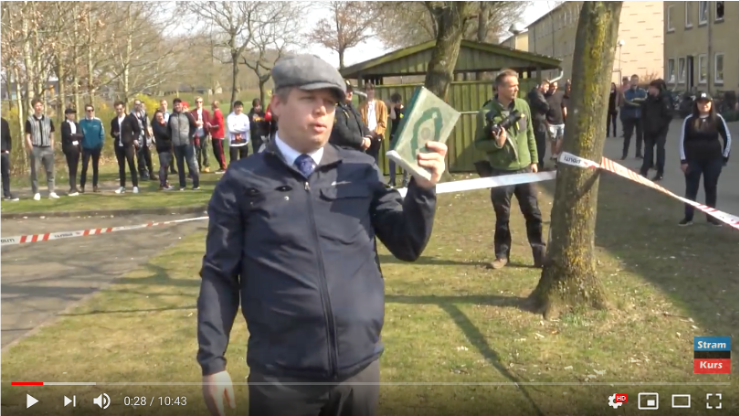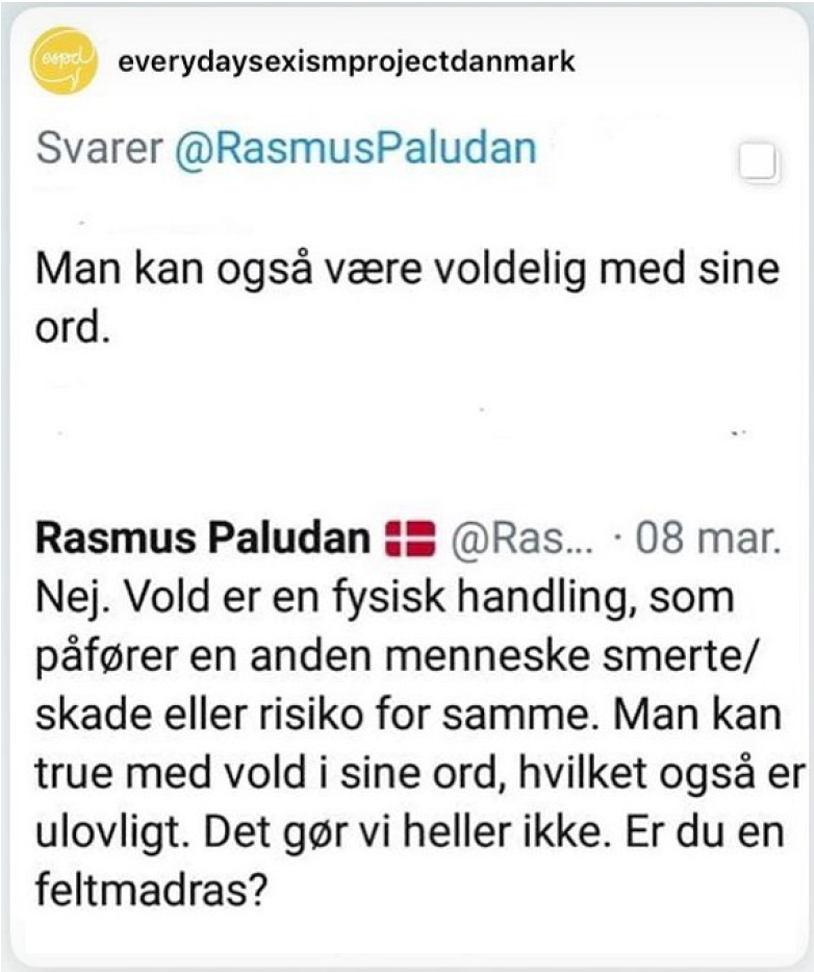Can language cause harm? Can a speech act be an act of violence? These are important questions – especially in times when citing the right to freedom of expression is used as a way to legitimize hate speech. This is a tactic employed by people like the Danish right-wing politician Rasmus Paludan (henceforth RP), who uses ‘freedom of speech’ as a shield to say very negative things about Muslims (among others). It is always interesting to expand your linguistic horizons, so in this blog post I will attempt to examine hate speech and linguistic violence with insights from affect theory and philosophy.
Harmful speech

To understand how language can be violence, let us begin by considering professor and philosopher Judith Butler’s theory of harmful speech. In Excitable Speech (1997), she describes how language can act and cause harm. She draws on John Austin’s theory of illocutionary or performative speech acts – i.e. speech acts that perform the actions they describe in the moment they are uttered. Examples of this could be the pronouncing of a sentence, an apology, or a declaration. An essential feature of these speech acts is that they depend on the right context and historicism (i.e. historical starting point). For example, for the pronouncement of a sentence to actually work as a speech act, it must repeat an existing power structure and an existing ritual. Language is intertextual, and we could say that speech acts ‘work’ because they has been used in the same way before. Thus, language can create real world effects in and of itself, and these effects depend on the repetition of language. Butler also draws on Louis Althusser’s theory of interpellation which states that so-called Subjects are called into existence through linguistic and social invocations. If a police officer yells “Hey!” at someone, this person will be recognized as a potential criminal. This means that the Subject is created by the discourse, and thus, the interpellation not only names Subjects, but also creates them. In this way, language can set the conditions for the existence and recognizability of human beings as particular Subjects.
If we accept Bitler’s theory, language can thus be harmful because it can act in and of itself (much in the same way that physical acts can), and simultaneously create and contextualize Subjects as inferiors. In other words, language can act in harmful ways and cause people pain, and these are the qualities that make it possible for language to become violence:
Hate speech
But what is the difference between harmful speech and outright hate speech? To answer this question we have to consider affect theory researcher Sara Ahmed’s discussion of hate crimes and hate speech from The Cultural Politics of Emotion (2004). Ahmed, like Butler, describes how hate crimes can contribute to the creation of Subjects. She argues that hate crimes work because they commit violent acts that affect whole groups through a single individual. But in addition, hate crimes force individuals to belong to the group that the hate crime is committed towards. The affiliation with a racialized group is thus both the cause and the consequence of the hate crime. This is an interesting addition to the theory of harmful speech – that language violence works by appointing the group and simultaneously targeting the individual and the group itself.
RP’s hate speech
When RP for instance shows up to protest on a public square and talk about “loser Muslims” and Islam as the cause of violence and human decay, we can categorize it as hate speech. First of all, he invokes people who are physically present in the public space and linguistically creates the conditions for them to be recognized as “losers” and “violators”. Secondly, he appoints them as part of a larger group, the members of which he also invokes as “losers” and “violators”. In this way, every attack from RP on Muslims as a group is also an attack on Muslim individuals. One of the reasons why the word “Muslim” can be a slur in RP’s rhetoric is because it both refers to Muslims as a group and to every single individual Muslim. This is the power of hate speech: It can affect everyone by affecting one, and it can affect one by affecting everyone. Another important condition for hate speech is that the shameful invocation also draws on existing discourses, cf. the previous point about the repetition of speech. Hate speech depends on a specific context to work: Using “Muslim” as a slur is possible because Muslims are already a minority group in Danish society, and because they are already spoken about in negative terms. In this way “Muslim” as a slur is both a repetition and a re-establishment of pre-existing history. If RP took to the streets to say mean things about librarians or people with curly hair, it wouldn’t work in the same way.
To sum up, RP’s shaming of Islam and Muslims is hate speech (and can be categorized as violence) for two reasons. Firstly, because it creates the conditions, both for single individuals and the groups they belong to, to be recognized as violent, decaying, inferior, etc. Secondly, this reinforces the pre-existing negative associations attached to Islam and Muslims by re-establishing them in a local context.
Legitimizing violence

In the beginning of this blog post, I mentioned how freedom of speech is used to defend hate speech, and this is a point worth returning to. Freedom of speech can only defend spoken utterances and not actual violence – so using freedom of speech to defend RP’s utterances means perceiving what RP does as “just utterances” and not as violence. As I have just argued, however, his utterances can be classified as hate speech and thus as violence. I think there are two reasons why RP’s linguistic violence is not recognized:
Firstly, to view utterances as violence we have to acknowledge that language can act and create Subjects. It is thus about understanding the power of language, and how language significantly contributes to our understanding of self and to our social relations. This is a post-structural premise – that language creates reality – but within the field of linguistics it is also a fundamental condition. Secondly, RP’s discourse is just a repetition of racist discourse, which already permeated society to begin with. Hate speech gets its power from the historicity and intertextuality of language, and thus the pre-existing opinions of Muslims set the conditions for everything RP says. In short, RP is not exactly the peak of human innovation.
The idea that language can not act, along with pre-existing racism in society, contributes to making RP’s actions unrecognizable as violence. And the problem arises as the violence is legitimized, which happens when we treat his utterances as actual political arguments, or when we call his opinions “extreme” and thus turn a blind eye to other politicians’ similar opinions. When the discussions about RP become discussions about how to protect freedom of speech, we both legitimize the violence and the underlying racist structures of society.
Recently, YouTube shut down RP’s channel, and he has been convicted of racism according to Danish criminal law several times, most recently less than a month ago. This not only shows resistance to the content of RP’s utterances, it also serves as declarations of the power of utterances. The discussion about RP’s right to speak publicly is not just about whether you agree with him or not. It is a discussion that touches on a fundamental quality of language – namely the way it perpetually reiterates and creates reality.
Liv Moeslund Ahlgren is an MA student of linguistics at Aarhus University. She has worked with gender studies and postcolonialism as a part of her linguistics minor.
This post was translated from Danish by Hannah Fedder Williams.
Translation of Twitter post:
@everydaysexismprojectdanmark: One can be violent with one’s words.
@RasmusPaludan: No. Violence is a physical act that inflicts pain/damage or a risk thereof on another human. One can threaten with violence with one’s words, which is illegal. And we don’t do that. Are you an army whore [lit. field matress]?








An excellent post, congratulations !!